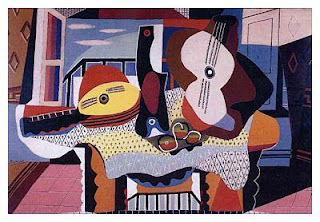Tree on Fire
- The steps were repeated for other parts of the fire.
- If I wanted to colour the branches, I just closed the layer of 'fire' and then used polygonal lasso tool to draw the shapes of the branches on a new layer.
- After filling up the colours of the branches and fire.
- There were still some pencil lines and 'holes' in the picture.
- I decided to filter the picture using 'palette knife'. (Filter>Artistic>Palette Knife)
- The pencil lines and 'holes' seem blurred out.
- But the branches appeared to stand out more than the fire. So I added the 'mosaic tiles' texture onto the picture. (Filter>Texture>Mosaic Tiles)
- After applied the 'mosaic tiles'.
- The complete artwork.
- The original sketch.
- Applied 'watercolor'. (Filter>Artistic>Watercolor)
- The result after applied the 'watercolor'.
- Then I added 'smudge stick'. (Filter>Artistic>Smudge Stick)
-Result after added the 'smudge stick'.
- The completed artwork.
- The original sketch.
- I used polygonal lasso tool to draw the shape.
- Then I used the gradient tool to choose the colour I wanted and filled up the selected area.
- I coloured the glass pieces first.
- Then I coloured the background using the same procedure.
- Using the same steps, I coloured the sides of the glass using darker colour than the colour on the front parts.
- Lastly just coloured the glass bottles.
- After filling up all the colours.
- I chose 'palette knife' again for my artwork.
- I then added 'water paper' to make my artwork brighter. (Filter>Sketch>Water Paper)
- The brighter and completed artwork.
Visual Treatment
i) Art Movement: Cubism
ii) Reference Artist: Pablo Picasso
iii) Theme Chosen: Environmentalism
iv) Ideation and Concept: Forest destruction is the main concept of this artwork. The tree represents the forest whereas the fire represents the destruction. Trees are important to us and I hope this artwork can convey the awareness among the people to stop the destruction of forest.
Cans
Visual Treatment
i) Art Movement: Cubism
ii) Reference Artist: Pablo Picasso
iii) Theme Chosen: Environmentalism
iv) Ideation and Concept: This artwork emphasize the recycling of cans rather than just throwing them around.
Glass
Visual Treatment
i) Art Movement: Cubism
ii) Reference Artist: Pablo Picasso
iii) Theme Chosen: Environmentalism
iv) Ideation and Concept: This artwork emphasize the recycling of glass.
Photoshop Process
~Tree on Fire~
- This is the original sketch.
- I used polygonal lasso tool to draw the shape of the fire so that I can fill the colour of fire.
- After using the gradient tool.
- If I wanted to colour the branches, I just closed the layer of 'fire' and then used polygonal lasso tool to draw the shapes of the branches on a new layer.
- After filling up the colours of the branches and fire.
- There were still some pencil lines and 'holes' in the picture.
- I decided to filter the picture using 'palette knife'. (Filter>Artistic>Palette Knife)
- The pencil lines and 'holes' seem blurred out.
- But the branches appeared to stand out more than the fire. So I added the 'mosaic tiles' texture onto the picture. (Filter>Texture>Mosaic Tiles)
- After applied the 'mosaic tiles'.
- The complete artwork.
~Cans~
- The original sketch.
- Applied 'watercolor'. (Filter>Artistic>Watercolor)
- The result after applied the 'watercolor'.
- Then I added 'smudge stick'. (Filter>Artistic>Smudge Stick)
-Result after added the 'smudge stick'.
- The completed artwork.
~Glass~
- The original sketch.
- I used polygonal lasso tool to draw the shape.
- Then I used the gradient tool to choose the colour I wanted and filled up the selected area.
- I coloured the glass pieces first.
- Then I coloured the background using the same procedure.
- Using the same steps, I coloured the sides of the glass using darker colour than the colour on the front parts.
- Lastly just coloured the glass bottles.
- After filling up all the colours.
- I then added 'water paper' to make my artwork brighter. (Filter>Sketch>Water Paper)
- The brighter and completed artwork.


















































